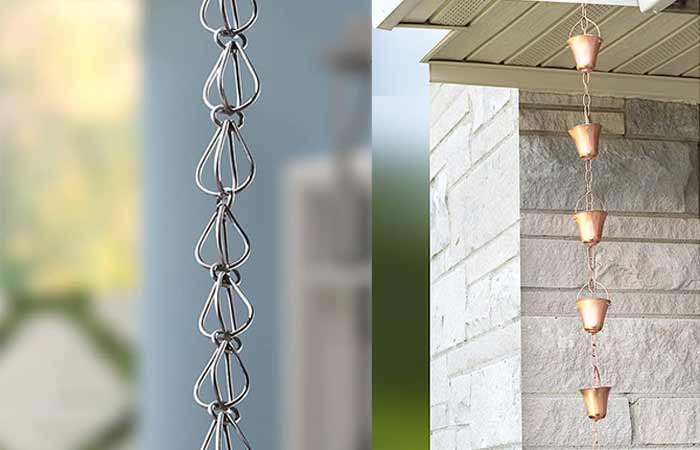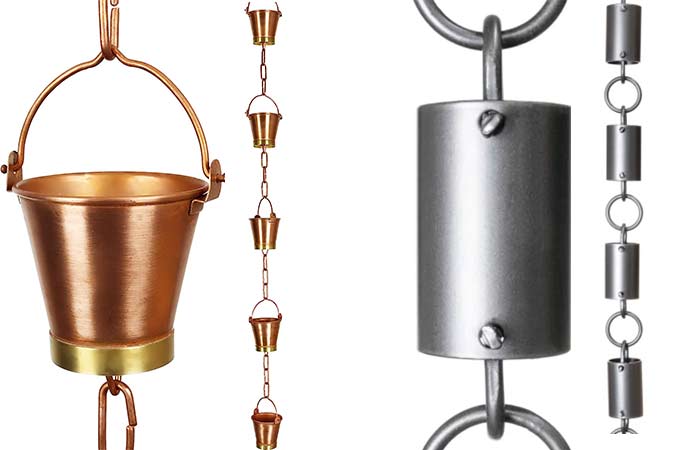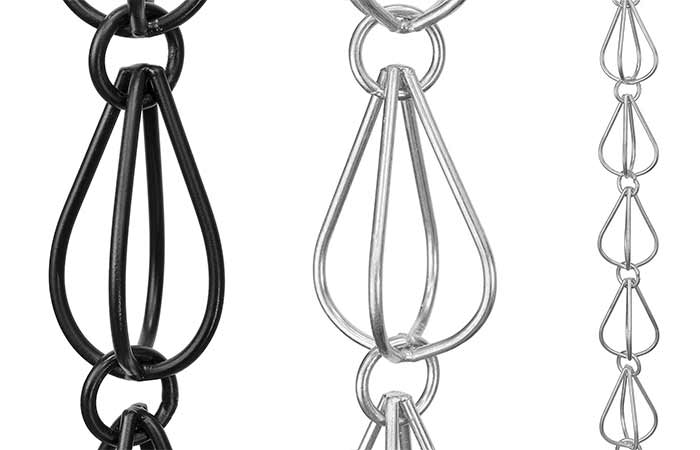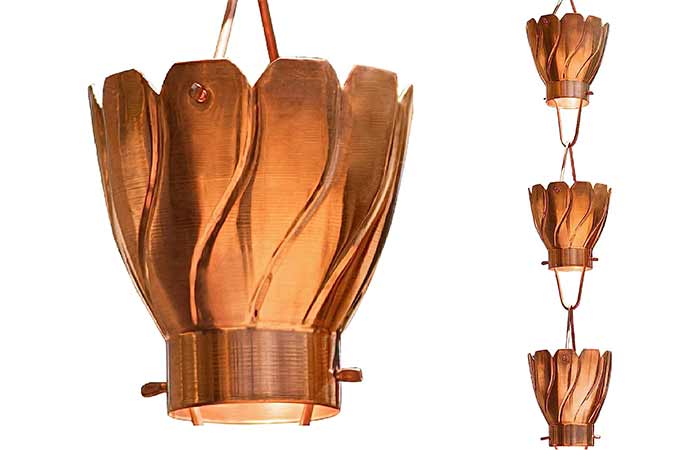Most of us have probably come across rain chains and wondered what they are and how they work. Rain chains are not only functional but also visually appealing alternatives to traditional downspouts that work by channeling rainwater from the roof into a basin or directly onto the ground.
Whether you’re just discovering rain chains or already well-acquainted with them, find out what exactly rain chains are, how they work, their purposes, benefit, different types and styles and more.
What are Rain Chains?
Rain chains are outdoor decorative accessories that are hung from the edge of a roof or gutter, used in place of traditional downspouts, to guide rainwater downwards or a suitable drainage system.

They are typically composed of chains or a series of linked cups, funnels, bells or other shapes that create a visually pleasing cascade effect as rainwater trickles down them.
Rain chains have a rich history and are deeply rooted in Japanese culture. In Japan, rain chains are known as “kusari-doi/toi” and have been used for centuries as functional and artistic elements in the design of temples and homes.
Also called rainwater chains or downspout chains, today, rain chains are becoming increasingly popular around the world for their unique blend of functionality and beauty.
How Do Rain Chains Work?
Rain chains work by using the natural force of gravity to guide rainwater from the roof to the ground. They are connected to gutters, or eaves, usually where a downspout is traditionally placed.
As the rain falls on the roof, the rainwater collects in the gutters. When the collected water starts to flow, it naturally takes the easiest path and follows the chain links down to the ground.
Rain chains create a gentler and more controlled descent which not only reduces erosion around the foundation of your home but also prevents soil displacement and water pooling in your garden.
As the rainwater flows into the rain chain, it cascades from one cup or link to another, creating a captivating visual and auditory experience. The gentle sound of water flowing down the rain chain adds a soothing and calming effect to any outdoor space.
Rain Chain Purpose: What are Rain Chains used for?
From channeling rainwater, and enhancing both the visual and auditory aspects of your outdoor space to collecting water rain chains serve different purposes. Most homeowners and landscape enthusiasts use rain chains for the following;
Managing the Flow of Rainwater
The primary purpose of a rain chain is to channel rainwater from the roof to the ground. Guiding the water along its length helps stop erosion and directs the flow away from structures or sensitive areas.
Aesthetics
In addition to their practical function, rain chains also serve as eye-catching decorative accents. The controlled cascade of water adds a touch of elegance to the exterior of your house.
Available in a range of designs, materials, and finishes, they allow you to personalize your outdoor decor and complement your architectural style. The carefully crafted cups, links, or other decorative elements create an inviting and sophisticated ambiance, making your space truly stand out.
Rainwater Harvesting
Some rain chains can be connected to a rain barrel or other collection system, allowing you to collect and store rainwater for various uses, such as watering plants or gardens.
This sustainable approach to water management lets you conserve resources while nurturing your green spaces.
Soothing Sounds
The gentle sound of rainwater flowing down a rain chain adds an enchanting auditory experience to your outdoor environment. This enhances the overall ambiance while introducing a sense of harmony.
Downspout/Gutter Alternatives
With their easy installation and minimal maintenance requirements, rain chains provide a convenient downspout alternative for homeowners or garden enthusiasts.
Whether you choose to hang them from a gutter or attach them directly to the roof’s edge, the installation process is straightforward.
Overall, rain chains serve as functional and visually appealing alternatives to downspouts, enhancing the beauty of your home’s exterior while efficiently managing rainwater runoff.
Rain Chains Pros
Rain chains offer numerous benefits to your outdoor space. Here are some reasons you should consider using rain chains:
Eco-friendly
Rain chains are a great way to conserve water and promote sustainability. Unlike traditional downspouts that quickly move water away from your home, rain chains slow down the flow of water, allowing it to be absorbed into the ground, replenishing the soil and groundwater. As mentioned earlier, you can also connect them to a water collection system to tap and hold water for other uses.
Noise Reduction
The gentle sound of water trickling down a rain chain is more soothing than the clunky noises produced by traditional downspouts. Rain chains can help reduce noise pollution, creating a more peaceful and relaxing environment.
Enhanced curb appeal
Rain chains come in a variety of styles and materials, allowing you to add a unique and personalized touch to your home’s exterior. They can complement the design of your home and enhance its overall aesthetic value.
Long-lasting
Rain chains made of durable materials such as copper and aluminum can last for years with proper care and maintenance. Unlike downspouts that can become clogged or damaged, rain chains offer a reliable and long-lasting solution for channeling water away from your home.
Ease of Installation and Maintenance
Rain chains are also super easy to install. Essentially, you hang them beneath the opening where the downspout would typically go. They’re also easy to customize and maintain, as each chain piece can be removed or replaced without needing special tools.
Variety
Another advantage of rain chains is the many DIY options available on the market. You can create handmade, customized and personalized rain chains that are relatively inexpensive, without much craft experience.
As mentioned earlier, rain chains provide a distinct and unique alternative to traditional downspouts or gutters.
Further Reading: Common Rain Chain Problems and Fixes
What are Rain Chains Made of?
Most rain chains are made out of copper and aluminum, but there are designs constructed from other materials including brass, iron, stainless steel, ceramic and glass. Each construction material comes with its own unique features, advantages, and disadvantages.

Copper: This is a popular choice for rain chains due to its durability and aesthetic appeal. Over time, copper develops a natural patina that adds character to the rain chain and makes it even more beautiful.
Aluminum: like copper, this is yet another common choice because it is lightweight, affordable easy to work with, and weather-resistant.
Aluminum rain chains can be painted or coated to mimic the appearance of other materials, such as copper or bronze, providing a versatile option for those seeking a specific look while maintaining durability.
Brass: Rain chains made from brass offer a similar aesthetic to copper but with a slightly different color tone. They are known for their durability and resistance to corrosion, making them suitable for long-term outdoor use.
Stainless Steel: Stainless steel rain chains are highly durable, corrosion-resistant, and low maintenance. They offer a sleek and modern appearance, making them suitable for contemporary or minimalist designs.
Iron: Iron provides a classic and timeless look. While they can be susceptible to rust, they are often treated with protective coatings to enhance their longevity and resist corrosion.
Glass: Glass adds a touch of elegance and color to your outdoor space. They are available in various designs and colors, creating a visually stunning and unique aesthetic. Glass rain chains are typically handmade and require careful handling and installation.
Ceramic: This material provides a delicate and artistic appeal. They are often handcrafted and can feature intricate designs and patterns. Ceramic rain chains should be handled with care due to their fragility.
It’s worth noting that some rain chains combine different materials, such as a combination of metal and glass or metal and ceramic, to create a more intricate and visually appealing design.
| Material | Pros | Cons |
| Copper | Beautiful patina over time; durable; weathers well | Expensive; may require occasional cleaning |
| Brass | Similar aesthetic to copper; durable; resistant to corrosion | More expensive than other materials; may require occasional cleaning |
| Aluminum | Lightweight; affordable; rust-resistant; versatile | Less visually striking than other materials |
| Stainless Steel | Classic and timeless look; Durable | Sleek and modern appearance; may be more costly |
| Iron | Lightweight; affordable; rust-resistant; Versatile | Susceptible to rust if not properly treated; requires maintenance |
| Glass | Elegant and colorful; visually stunning | Fragile; requires careful handling and installation |
| Ceramic | Delicate and artistic appeal; intricate designs | Fragile; requires careful handling and installation |
Remember that the pros and cons listed above are general considerations and may vary based on the specific quality and craftsmanship of the rain chain. When choosing a rain chain be sure to consider the specific requirements of your space.
Rain Chain Types & Styles
Homeowners can choose from two main types of rain chains: links or cups. Both options come in several styles and materials.
Link-style/Cup-less Rain Chains
They typically consist of a series of interconnected metal links, creating a chain-like pattern that allows the water to cascade down, giving a visually appealing and decorative look.

The links can be as plain or ornate as you’d like, such as basic oval links, twist loops, rectangular links, or Fleur-De-Lis designs. The most common colors include silver, gold, copper, oil-rubbed bronze, black, white, and copper patina
They are more streamlined which makes them provide a gentle and soothing sound as the water flows through the links.
Link-style rain chains are often lighter in weight compared to cup-style rain chains, making them easier to install and maintain.
However, they are not as effective in heavy rainfall situations as cup-style rain chains. The open links may allow some water to splash or spray outside the desired area, potentially leading to water runoff concerns. They also don’t collect and retain water as effectively as cup-style rain chains.
Cup Style Rain Chains
These rain chains feature individual cups or containers arranged in a chain-like pattern. The containers are often wider at the top and taper towards the bottom to guide the water down the chain.

Further Reading: How to Choose the Best Rain Chain+ Top-Selling Options
Cup rain chains also come in various designs. The cups can be round, square, conical, scalloped, or even triangular. Often, they are patterned after nature or architecture from East Asia.
The cups might be reminiscent of honeysuckle, calla lilies, koi, or a Japanese pagoda. However, you can also find geometric designs and kitschy shapes, such as umbrellas or watering cans.
Cup-style rain chains can handle heavier rainfall better than link-style rain chains since the cups provide more containment and control. They are often considered more functional in directing water away from the building’s foundation.
However, cup-style rain chains can be heavier than cupless rain chains due to the cups’ weight, which can make installation and maintenance slightly more challenging.
Some cup-style rain chains may produce a louder sound as water flows through the cups, which could be a pro or con depending on personal preference.
Themed Styles
These consist of creative and personalized designs, shapes and patterns that tie into a specific theme. In most cases, these themes reflect your interests, hobbies, or the overall theme of your outdoor space.
Further Reading: How to make your own DIY Rain Chain: Unique Ideas & Designs
FAQs
Here are some frequently asked questions about rain chains:
Can Rain Chains Work for Heavy Rains?
Rain chains can work for heavy rain if they are paired with gutters and a water collection or drainage system, such as a rain barrel or French drain. Cup-style rain chains will work better for heavy rain than link-style rain chains.
Further Reading: Rain Chains vs Gutter Downspouts
Do Rain Chains Make Noise?
Yes, rain chains can make some noise when it is raining. The noise/sound comes from the water moving through and dripping off the chain. This can be a pleasant ambient sound or fairly loud during heavy rains, depending on the location. If you are installing them near a window or door, consider the noise levels.
Where are Chains Placed on the Roof?
Rain chains should be placed at the corner of the gutter or the downspout outlet of your gutter system where a downpipe would usually be. That might be on the eaves of your house, on your shed or a garden building, or on your garage. If your roof has no gutters here are some gutter-free rain chain ideas
When it rains, the water gently flows down the rain chain to the bottom, where it can be collected in a barrel or decorative water feature, or channeled into the garden to irrigate the flower beds.
Where Can I Use Rain Chains?
Rain chains can add a beautiful touch to any outdoor space. They are versatile and can be used in a variety of settings.
If you have a garden, consider installing a rain chain in place of a traditional downspout. The gentle sound of water cascading down the chain can add a relaxing element to your outdoor space. You can also use rain chains as a decorative element on your patio or balcony.
Rain chains can also be used on a larger scale in commercial buildings or public spaces. They can add a unique and eye-catching element to the design of a building. Additionally, rain chains can be used to direct water to a specific location, such as a rain garden.
Some Creative Ideas:
- Hang multiple rain chains from a pergola or gazebo to create a stunning water feature.
- Replace traditional downspouts with rain chains along the side of a barn or shed for a rustic look.
- Use rain chains as a divider between different areas of your outdoor space.
Where Can I Purchase Rain Chains?
There are many options for purchasing rain chains, both online and in-store. Home improvement stores like Home Depot and Lowe’s often carry a selection of rain chains, as do garden centers and specialty decor shops.
If you prefer to shop online, a quick search will yield endless options for rain chains in a variety of materials, designs, and prices. Some popular online retailers include Amazon, Etsy, and Wayfair.
When choosing a rain chain, it’s important to consider the material and design that will best suit your needs and personal style. You may also want to look for rain chain accessories like basins and catchers to complete the look and function of your rain chain system.
Can I Install a Rain Chain Myself?
Yes, many rain chains can be easily installed as a DIY project. However, it is important to follow the manufacturer’s instructions and use the proper tools. If you are unsure about how to install a rain chain, it may be best to seek the assistance of a professional.
Further Reading:
Can Rain Chains be Used in Cold Climates?
Yes, rain chains can be used in cold climates. However, it is important to ensure that the rain chain is properly installed and maintained to avoid any damage caused by ice or snow buildup. It may also be helpful to choose a rain chain with larger cups or links to accommodate for potential freezing.
Sources
- https://hgic.clemson.edu/factsheet/rain-chain/
- https://www.monarchabode.com/pages/monarch-rain-chain-wikipedia
- https://cals.arizona.edu/backyards/sites/cals.arizona.edu.backyards/files/p11-12_0.pdf
As an Amazon Associate, we earn from qualifying purchases. Details here
